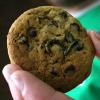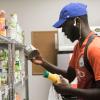Waste Not, Want Not: A Clarke Middle Class Repurposes Leftover Food
The Locavore

Photo Credit: Wick Prichard
Officer Jason Cook collects unopened milk cartons and uneaten fruit to make smoothies in a Clarke Middle School food science class.
Depending on the day, you might detect the scent of apple and cinnamon wafting through the air. You may hear the whir of a blender whipping together a fruit and kale smoothie or the thick glub of jam bubbling on the stove. These are just a few of the tasty morsels students at Clarke Middle School are creating in their food science classes, and some of the ingredients they’re using are food waste.
Don’t think garbage or spoiled food, though, says Hope Zimmerman, Clarke Middle’s family and consumer science teacher. The foods she and her students use are uneaten lunchroom leftovers—whole pieces of fruit, unopened milk and juice cartons or packs of carrot sticks, for example.
The reclaimed food labs are just another product of Clarke Middle’s evolving sustainability culture. Debbie Mitchell thinks they might be the most important program yet. As Clarke’s agriculture science teacher, Mitchell introduces her students to growing food, but bringing food into the classroom, she says, completes the picture for her kids. “They start to see how it all works together,” says Mitchell.
The agriculture science classroom works in partnership with Zimmerman’s family and consumer science class to present a holistic view of food, from seed to plate, and now post-plate. Over the school year they will teach around 500 students, mostly sixth graders. Zimmerman thinks it’s good to start these lessons early. “Sixth graders are a blank slate,” she says. “They buy in more easily than the older kids.”
Her reclaimed food labs began a little over a year ago as an idea that progressed from the school cafeteria composting program. “It all started with having too much food,” says Wick Prichard, the school’s AmeriCorps/VISTA volunteer from 2012–2015. Prichard and Mitchell couldn’t help but noticed how many whole fruits they were collecting for compost. “Composting is the last step you want,” says Prichard. “Ideally, you want the kids to eat the fruit.”
Though students were encouraged to place untouched foods into separate bins, fruits were still getting tossed. So, bowl in hand, Prichard stood by the trash can for a year, collecting every banana or apple that came his way. Eventually the students caught on, and now they can leave the foods they don’t want in bowls on the lunch tables. On an average day, Prichard estimates the school collects around 40 bananas, 20 cups of milk and juice and 40–50 fruit cups.
The food, along with unopened milk, juice and other items, was stored in Zimmerman’s classroom. At first, she gave out fruit or milk as an afternoon snack. But the excess started piling up, and one day Zimmerman decided to use all the extra apples she had to make apple carrot muffins. Her kids loved it. Since then, Zimmerman’s class has made pear butter, apple bread and carrot juice, all using reclaimed food or produce from the school garden. “I probably save the school district hundreds of dollars using food from the cafeteria,” she says.
How to reduce the amount of perfectly good food people throw away is a question puzzling experts across the world. According to the Natural Resources Defense Council, the U.S. wastes 40 percent of its food. Within their classrooms, Mitchell and Zimmerman are working to show kids how to be mindful of food.
Zimmerman thinks the lesson is sinking in: “One class, we had pears as a snack, and when one boy tried to throw the core away in the trash can, the other kids yelled at him, ‘What are you doing? You’re supposed to compost that!’”
Mitchell likes to emphasize how the recipes she makes with her kids can be modified. Though the students may not have the same list of ingredients, “they need to know that they can make these recipes at home,” she says. Zimmerman agrees. The students’ favorite kale smoothie recipe is an easy example, she says, to show kids how to work with what they have on hand.
Sustainability programs are gaining momentum across the school district. Gardens have popped up in Clarke County’s three other middle schools. Mitchell and Zimmerman hope the next stop is the district high schools. For now, they’re eager to see how the program grows in the next year. “It’s not finished,” says Zimmerman, and that’s what’s exciting about it.












comments